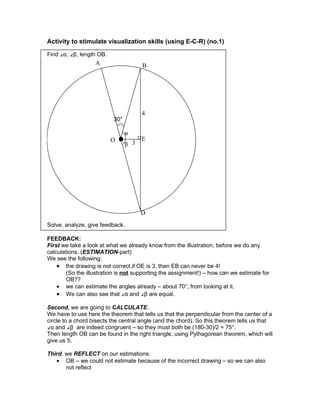
Angles
- 1. Activity to stimulate visualization skills (using E-C-R) (no.1) Find ∠α, ∠β, length OB. A B 4 30° α O E β 3 D Solve, analyze, give feedback. FEEDBACK: First we take a look at what we already know from the illustration, before we do any calculations. (ESTIMATION-part) We see the following: • the drawing is not correct.if OE is 3, then EB can never be 4! (So the illustration is not supporting the assignment!) – how can we estimate for OB?? • we can estimate the angles already – about 70°, from looking at it. • We can also see that ∠α and ∠β are equal. Second, we are going to CALCULATE. We have to use here the theorem that tells us that the perpendicular from the center of a circle to a chord bisects the central angle (and the chord). So this theorem tells us that ∠α and ∠β are indeed congruent – so they must both be (180-30)/2 = 75°. Then length OB can be found in the right triangle, using Pythagorean theorem, which will give us 5. Third, we REFLECT on our estimations: • OB – we could not estimate because of the incorrect drawing – so we can also not reflect
- 2. • The angles have the expected size…. However: there is also another way to find the angles. And since the proportions of the lengths are not good, maybe the angles are also not good! If we use the tangent-function in ΔOBE, we will find that both angles should be about 53°! As is shown above: if we want our students to use their common sense, to use what they see (visualization skills!!), then they will be very discouraged if they get an activity like above. Below, you see the corrected activity: Find ∠α, ∠β, length OB. A B 4 74° α E O β 3 D
- 3. Activity to stimulate visualization skills (using E-C-R) (no.2) B BC = 6, AD = 5. What is the length of DB? D C A First, we will list down what we already know: • we write 6 in the illustration, at side BC • we write 5 at AD • we estimate for the length of DB • we identify all the congruent angles and write different symbols in the angles • we make a ratio-table in which we list all the sides, and also what we already know B 6 D 5 We immediately see that the drawing is incorrect: AD= 5 – then BC should be something like 15! So how can we estimate for BD?? C A
- 4. We can still make a ratio-table, but we already know that we cannot use the illustration as support anymore… (Of course, we can also separate the triangles, to make it easier for the students to see where all congruent angles are…) ΔABC AB = BD + 5 BC = 6 AC ΔCBD CB = 6 BD CD ΔACD AC CD AD = 5 Second: we calculate. But that it easier said than done, in this case. To be able to do any sensible calculations, we need to express AB in BD, or BD in AB….this time, it was chosen to rewrite AB as BD+5…. We can also “see” that AB is to BC is equal to BC is to BD. We solve by cross-multiplication: 6 ⋅ 6 = BD ⋅ ( BD + 5) ⇔ BD 2 + 5BD − 36 = 0 ⇔ ( BD + 9)( BD − 4) = 0 ⇔ BD = -9 or BD = 4; of course BD can not be –9, so BD = 4. (By the way: what is the objective of this exercise? To do (complicated) algebra, or to practice finding similarities? – in other words: does it have to be so complicated?) Third: we reflect. We found BD = 4, which can not be correct if we base ourselves on the drawing. But then again; the drawing was already wrong, so we can not use that. We can use the ratio of the sides, and if BD = 4, then AB = 9, and 9 is to 6 is equal to 6 is to 4, so AB should be 4 indeed. Corrected illustration: B D C A
